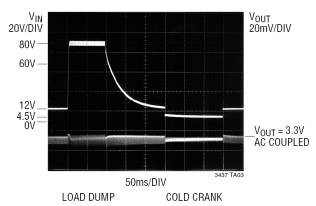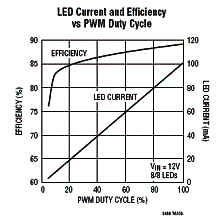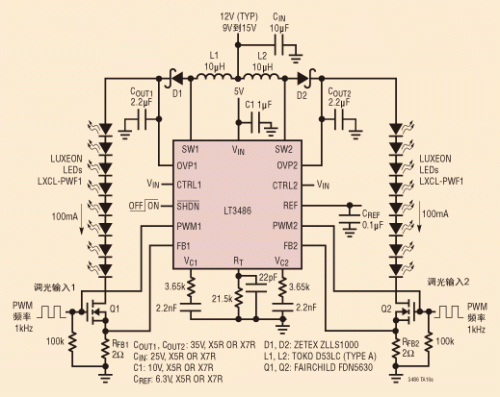As the number of electronic components used in automobiles continues to increase rapidly, we can expect power conversion ICs to face more design challenges: some devices require stable voltage input, low quiescent current, and low noise, while others need to be satisfied. Customized for specific applications such as LED lighting, all devices require a smaller footprint and the highest possible efficiency.
This article refers to the address: http://
Every year, cars are increasingly adding more and more complex electronic systems. Market research firm IC Insights expects the automotive semiconductor market to grow from $12.5 billion in 2005 to more than $18.1 billion in 2008. Another market research firm, Strategy Analytics, is equally optimistic about this market: today, in the total cost of automobiles, electronic system costs account for more than 20%, and by 2008 this proportion will exceed 30%. Electronic systems installed in automobiles include infotainment systems, engine management, collision avoidance radar, satellite radios and televisions, hands-free cellular phones, and Other wireless connectivity systems. These systems used to appear only in European “upscale†luxury cars, but are now being integrated into more “mainstream†cars, which has accelerated the growth of the automotive IC market.
One of the most obvious areas of growth is the DVD/HDD-based infotainment system, which is standard on most mid- to high-end cars. This type of system was first introduced in 1997 and is expected to exceed 15 million worldwide in 2006. Such infotainment systems include at least navigation systems, AM/FM radios, and CD players, but now more and more systems are adding DVD players with multiple outputs, satellite radios, and even in some cases Satellite TV. These systems have become more complex year after year, with options for rear-facing car cameras, distress communication systems, and Bluetooth-compatible hands-free cellular phones.
At the same time, the number of components in these systems is increasing, while the available space is shrinking. Therefore, any practical radiator is too large for the system to accommodate. As a result, power conversion efficiency is a key factor due to space constraints and operating temperature requirements. At low output voltages and even medium current levels above a few hundred milliamps, simply using a linear regulator to generate the voltages used in such systems is no longer feasible because too much heat is generated. Therefore, switching regulators are replacing linear regulators primarily due to thermal limitations. The benefits of high efficiency and small footprint of switching regulators are more beneficial than the accompanying complexity and EMI issues.
These complex systems require a large number of voltage rails in a reliable and compact layout. Designing switching power supplies for such systems presents new challenges to power supply IC design. Figure 1 illustrates the complexity of today's infotainment system.

Figure 1: Modern infotainment system.
A typical infotainment system may have 8 or more different power sources, such as 8.5V (8.5V in Europe, 9.5V in Japan), 5V, 3.3V, 2.5V, 1.5V, and 1.2V. The 8V is used as a DVD motor power supply for rotating discs, which typically requires up to 2A of peak current. 5V and 3.3V rails are typically used on the system bus and typically require 2A to 3A current. The 2.5V rail is used for memory and I/O, and 1A to 2A current is sufficient. The 1.5V and 1.2V rails are used to power the CPU and DSP cores, respectively. The power levels of these two voltage rails are typically between 3W and 5W.
In addition to these higher current applications, lower power levels (less than 1 W) are required for the main TFT-LCD display (typically 7 inches to 10 inches) and the bias of the camera CCD. A 5W to 10W power stage is also required for white LED backlighting of TFT-LCD displays.
Since all of these power requirements are met, a variety of switching regulators can be found in most infotainment systems. In a more favorable electrical environment, a switching regulator for portable products can be used. However, some power supply ICs face a much harsher electrical environment, which presents a large design challenge. For example, whenever a power rail is generated directly from a battery/charging system, a wide input voltage range is required to meet the extreme voltage swing requirements. If a particular system needs to remain "always on", then the most important thing is to have the lowest quiescent current. Similarly, switching regulator ICs with switching frequencies close to the AM/RF/GPS circuit frequency must not interfere with these bands. LED driver ICs for TFT-LCD backlighting must have a wide dimming range to compensate for the slightest changes in ambient light. Finally, all DC/DC converters should be as small as possible to fit the compact layout and be as efficient as possible to eliminate the need for heat sinks.
Battery powered
Regardless of the application or subsystem in the infotainment system, the power supply initially comes from the car battery and charging system. However, car batteries or charging systems are just the most demanding places in the electrical environment. With regard to power supply integrated circuits and subsystems powered by these integrated circuits, there are two main concerns: load dump and cold cranking.
1. Load dump (60V transient protection):
“Load dump†is what happens when the alternator is charging the battery and the battery cable is disconnected. Figure 2 shows a typical voltage transient caused by a load dump. Sudden disconnection when the alternator attempts to fully charge may produce transient voltage spikes of up to 80V. Transient voltage suppressors on alternators typically clamp the bus voltage between 36V and 60V. However, the downstream mains DC/DC converter of the alternator may still be subject to a 60V transient voltage spike. Since these converters and subsystems powered by the converters will function properly during and after this transient event, it is critical that the DC/DC converter be able to handle these high voltage (60V to 100VMAX) transients. Various protection circuits (usually transient voltage suppressors) can be implemented externally, but external circuits increase cost and require valuable space. Linear Technology's high-voltage switching regulators, such as the LT3433, LT3434/5, LT1976/7, and LT3437/8, can withstand transients up to 80V while maintaining output regulation without affecting system performance or reliability. . In general, these regulators are step-down or buck-boost to withstand voltage changes in automotive and alternators caused by charge/battery system interruptions.

Figure 2: Load/drain and cold-start input/output voltage changes over time.
In summary: the load dump transient is a voltage spike caused by an accidental disconnection of the battery being charged; the load dump transient specification is 36V to 80V, but depends on which generation of power supply is used and the control method used; With suppression, load dump transients can damage many electronic components on the power bus.
2. Cold car launch (4.5V to over 60V input transient):
"Cold car launch" is what happens when a car engine has passed a period of time in cold or freezing temperatures. At this point the oil becomes very viscous and requires an engine starter to provide greater torsional force, which in turn requires the battery to provide more current. This high current load pulls the battery/main bus voltage down to 4V at startup, after which the voltage typically returns to the nominal 13.8V. Figure 2 graphically illustrates the voltage variation over time when the cold car is started. The problem is that some subsystems require a very constant, stable output throughout the cold start. These applications typically operate at 3.3V, including the engine control unit (ECU) and the environmental and emergency systems that are critical to the safe and reliable operation of the vehicle.
Any switching regulator connected directly to the battery needs to be specified to operate over a wide input voltage range of 3 to 60V to ensure that cold cranking and load dump conditions are met. In addition, the 60V rated 14V system provides excellent margins, and these systems are often clamped to the 36V to 40V range. Devices that meet these requirements include the LT3430 and LT3431, which are ideal for applications requiring up to 2.5A of output current and the LT1766 and LT1767 to meet 1.25A current requirements.
Always switch on the system
Typical infotainment systems have subsystems that need to work all the time: such as GPS receivers, IR systems, and system microprocessors. Since the car ignition is sometimes disconnected, these subsystems must be connected directly to the battery to operate in a low power mode. This requires a minimum quiescent current and requires these subsystems to withstand the voltage variations of the battery and charging system when the ignition is turned "on". Coupled with other power systems in the car, the requirements for batteries are getting higher and higher, even when the ignition is off. In general, a few hundred milliamps of supply current is required to maintain the voltage required to always turn the processor on, which can completely drain the battery in a matter of weeks. To better meet these needs, some automakers are looking for a "quick-on" DC/DC converter to achieve a maximum quiescent current "target" of 100uA.

Figure 3: Schematic and supply current for the LT3437 for automotive applications
However, until recently, in terms of converters, high input voltages and low quiescent currents were mutually incompatible parameter requirements. Linear Technology's high voltage (60V to 80V) 100uA step-down DC/DC converter family is the first to meet both of these requirements. This family of devices has a maximum input voltage range of 60V to 80V and an output current range of 450mA (LT3437) to 2.5A (LT3434) with quiescent currents below 100uA.
Figure 3 shows the schematic of the LT3437 and the synthesized supply current. The device maintains a regulated output voltage of 3.3V with an input voltage of 4.5V to 80V while delivering over 80% efficiency. It is available in a leaded thermally enhanced TSSOP-16 package or a 3mm x 3mm slim leadless DFN package. Both packages have very high thermal efficiency with a θJC of only 10°C/W, eliminating the need for any external heat sink. The LT3437 features a unique burst mode design that operates from a supply current of only 100uA, making it ideal for always-on applications. Similar devices such as the LT3434 and LT1976 can also be used in higher current applications such as those with output currents of 2.5A and 1.25A, respectively.
Reconverted power rail
Regardless of whether the power supply is 3.3V or 5V, many internal circuits can be directly driven after entering the information system, because many circuits can operate with 2.7V to 5.5V. However, there are several circuits that require higher or lower voltages than the original voltage rails. The most obvious is the CD/DVD drive motor, which requires 8.5V. Some CPUs and DSPs require 1.2V to 1.5V, and CCDs facing the rear camera require bias voltages (15V and -8V). TFT-LCD displays require both bias voltages (8V, 15V, and -8V) and white light. LED lighting (up to 36V). Fortunately, in general, the main power conversion of the battery has been to protect these voltage rails from transient and overvoltage changes, so there is no need to protect these reconverted power supplies. However, minimizing switching noise has become the most important issue because many power conversions take place near noise-sensitive AM, RF or GPS receivers. As long as the switching behavior is predictable, these potential noise and EMI are manageable in many sensitive applications, as has been confirmed. If the switching regulator is switched at a constant frequency in normal operation and the switching edges are clean and predictable, there is no overshoot or high frequency ringing, then EMI is minimized. In addition, if the regulator can use low-ESR ceramic capacitors, the input and output voltage ripple can be minimized, and this ripple is a potential source of noise in the system.
Motor for driving DVD/CD
A motor that drives a DVD/CD requires up to 2A at 8.5V to rotate the CD/DVD disc. Due to this relatively high load at 8.5V, it is typically powered directly from the battery, reducing the battery voltage to 8.5V. This solution achieves higher efficiency than boosting from a lower voltage rail to 8.5V. Direct battery-powered converters require a stable input voltage capability to protect the motor drive from high voltage transients. Linear Technology's LT3430 provides both transient protection and the required output current for this application. With up to 90% efficiency, the device is packaged in a thermally enhanced TSSOP-16 package with low heat dissipation and a small footprint.
Microprocessor and memory power
There are some microprocessors in any infotainment system. Both of their cores require a 1.2V to 2.5V supply, and both their memory and I/O require 2.5V or 3.0V, so they need to step down from a 5V main supply or a 3.3V intermediate rail. Efficiency is of the utmost importance because these subsystems are very compact and there is no extra place to place the heat sink. The LTC3407-2 is a voltage regulator that meets the above requirements. Its synchronous rectification topology provides efficiencies as high as 96% while its constant switching frequency is 2.25MHz, keeping noise out of the sensitive AM band of adjacent audio receivers.
TFT-LCD panel and CCD bias
A TFT plate (diagonally 6 inches to 10 inches) requires a current of up to 450 mA in addition to an intermediate voltage of approximately 8 V (commonly referred to as AVDD), typically requiring lower bias supplies such as 16V/10 mA and 8V/10 mA. Linear Technology's LT1935 is an ideal choice. With an LT1935 efficiency of up to 80%, the ThinSOT package retention solution has the smallest footprint. CCDs facing the rear camera also require some type of bias supply, typically 15V/20mA and -8V/50mA. Linear Technology's LT3472 is a low noise, constant frequency (1.1MHz) dual output boost/negative output IC that operates from a 2.2V to 16V input to provide the required CCD bias voltage. Its 3mm x 3mm DFN package minimizes solution footprint while providing excellent thermal performance.
TFT-LCD white LED backlighting
In addition to the bias voltage, TFT-LCD displays also require backlighting for viewing. Traditionally, backlighting has been implemented using CCFL. However, because white LEDs are smaller in size and more reliable, they have quickly replaced CCFLs in backlighting applications. Due to the light changes in the interior of the car and the sensitivity of the human eye to small changes in light intensity, backlighting of these displays is required to have a wide dimming range of up to 1000:1. Linear Technology's LT3486 (see Figure 4) can solve this problem. The device is a dual output step-down DC/DC converter designed to drive up to 16 100mA white LEDs with 12V input voltages (8 LEDs per channel in series). It acts as a constant current source, keeping the brightness of the LED constant, even when the forward voltage of each LED is different. The LT3486 is the first LED driver to use True Color PWM dimming to provide a constant current to the LED, keeping the LED lit in a constant color. Dimming reduces the duty cycle control of the PWM driver. As can be seen from Figure 4, the efficiency of the device is between 80% and 90% for most desired dimming ranges. Its thermally enhanced TSSOP-16 package is small and thermally efficient.

Figure 4: Schematic and efficiency of the LT3486 automotive TFT-LCD backlighting.
This article summarizes:
As the number of electronic components used in automobiles continues to increase rapidly, we can expect that power conversion ICs will face more design challenges. Some devices require stable voltage input, low quiescent current, and low noise, while others require specialization to meet the needs of specific applications such as LED lighting. All devices require a smaller footprint and the highest possible efficiency. Linear Technology has recognized this trend and has developed power integrated circuits that enable the acceleration of electronics in automobiles.
It can be equipped with different type of storage battery such as lead acid battery, Nickel Cadmium Battery, silver zinc battery, Lithium Ion Battery and other storage batteries, providing various output voltage classes.
Built-in storage battery and charger, equipped with the function of over-charge and over-discharge protection and capacity display. It is used as working power supply for lightings, communications, laptops, and special instruments of emergency working, field working, press interviews, special vehicles and other fields.
Dc Power Supply,110V Dc Power Supply,220V Dc Power Supply,110V Dc Power Supply System
Xinxiang Taihang Jiaxin Electric Tech Co., Ltd , https://www.agvchargers.com